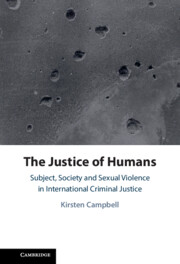Book contents
- The Justice of Humans
- The Justice of Humans
- Copyright page
- Dedication
- Contents
- Figures
- Acknowledgements
- Abbreviations
- Note on Case Citation Abbreviations
- 1 The Justice of Humans?
- Part I Subjectivity and Sociality in Contemporary International Criminal Law
- Part II The Women’s Court and Transformative Gender Justice
- 7 The Women’s Court and the Feminist Approach to Justice
- 8 Building a Feminist Approach to Justice for International Criminal Law
- 9 Building a Feminist Justice Approach to International Criminal Law in Practice
- Bibliography
- Index
7 - The Women’s Court and the Feminist Approach to Justice
from Part II - The Women’s Court and Transformative Gender Justice
Published online by Cambridge University Press: 08 December 2022
- The Justice of Humans
- The Justice of Humans
- Copyright page
- Dedication
- Contents
- Figures
- Acknowledgements
- Abbreviations
- Note on Case Citation Abbreviations
- 1 The Justice of Humans?
- Part I Subjectivity and Sociality in Contemporary International Criminal Law
- Part II The Women’s Court and Transformative Gender Justice
- 7 The Women’s Court and the Feminist Approach to Justice
- 8 Building a Feminist Approach to Justice for International Criminal Law
- 9 Building a Feminist Justice Approach to International Criminal Law in Practice
- Bibliography
- Index
Summary
This chapter examines the feminist approach to justice of the Women’s Court, a leading feminist alternative justice mechanism held in the former Yugoslavia. It describes the critique of existing models of international justice in the Women’s Court, together with its development of a new paradigm of justice and its building of an alternative justice mechanism. The chapter identifies the fundamental categories of the new feminist paradigm of justice: (1) transformative feminist justice; (2) gender-based harms; (3) feminist justice proceedings; (4) feminist judgement; and (5) subjects of justice. Drawing on feminist psychoanalytic theory, the chapter analyses the discursive structure and operation of this feminist model of justice, showing it expresses alternative forms of global exchange between women as subjects of justice. It argues that the Women’s Court creates new forms of feminist knowledge, which can represent new feminist social relations and values. The chapter traces how Women’s Court both articulates the structural injustices produced by the intensification of neoliberal globalisation in the former Yugoslavia and expresses the alternative possibilities of social solidarity and emancipation that can emerge in the same global social processes.
Keywords
- Type
- Chapter
- Information
- The Justice of HumansSubject, Society and Sexual Violence in International Criminal Justice, pp. 201 - 241Publisher: Cambridge University PressPrint publication year: 2022



